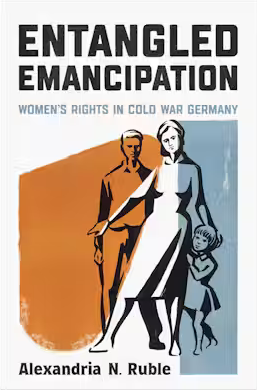

In the immediate aftermath of World War II, Germany was in a dire situation. Its major cities were in ruins. Key infrastructure was destroyed, the housing stock was depleted, and hunger was widespread. Death and disease were spreading rapidly. The promises of National Socialism—national renewal, Lebensraum, economic stability, and growth—were found to be hollow in the face of total defeat and growing awareness of Nazi crimes. Additionally, Germany was geographically divided and occupied by its former enemies. Together, the four Allied Powers—the US, the USSR, the United Kingdom, and France—attempted to govern and, after securing reparations, rebuild the war-torn country. But any work towards compromise and joint government between the powers was soon thwarted by the emerging Cold War tensions that pitted the US and Western Allies against the Soviet Union. Playing out irrevocably on German soil, the breakdown of Allied cooperation eventually led to the official division of Germany in 1949, a separation that would last until 1990.
But the Cold War in Germany not only played out in the high politics of the superpowers. There is now a body of research that shows how Cold War tensions infiltrated the minutiae of life in divided Germany: from interior design and egg cups to city planning and the family, everyday life was variously shaped in response to the Cold War. Alexandria Ruble steps into this field with her new book, which examines how women’s rights, or more specifically the legal implementation of women’s rights in the family, were negotiated in the context of and in relation to the Cold War division of Germany. At a time when anti-genderist and populist politics in Europe have revealed the fragility of women’s rights and the enduring power of naturalized notions of gender difference, this book provides an important historical reminder that the hard-won path of gender equality was never a foregone conclusion, but one that relied on the work of women who demanded their rights be recognized.
In what is already a crowded field, Ruble distinguishes herself by examining the entangled histories of women’s emancipation in postwar Germany. Despite the parallel development of and similarities between the two Germanys, for a long time historians have been reticent to study the history of the two German states together, preferring to focus on one Germany or to write comparative analyses. In contrast, Ruble explores the development of gender equality laws in both Germanys as “entangled histories in the sense that the two Germanys constantly influenced each other” (9). This approach does more than simply compare and highlight similarities and differences; instead, examining legal and political debates, alongside women’s activism and the media, Ruble looks at the way division and Cold War competition brought legal developments in the two states into conversation in ways that fundamentally shaped the politics of divided Germany.
In this pursuit she explores much more than just Cold War political entanglements. She examines how legal reforms were experienced by everyday Germans, and how everyday practices were informed or shaped by the law. She also looks at temporal entanglements and how the formation of protections for women’s rights in East and West Germany were bound up with the histories of women’s organizing in Germany prior to 1933. To a lesser extent, she also situates women’s rights in East and West Germany within the broader context of a divided Europe, underscoring both what is shared in the history of gender equality in the family and what is uniquely German.
In a departure from other studies, the Nazi past plays a less prominent role in Ruble’s study, which instead emphasizes how, from the first moments of occupation, women’s roles and rights were entangled in Cold War politics, the Weimar and Imperial German pasts, and women’s experiences during the war. As a part of denazification processes, the occupation powers removed many of the laws dealing with gender, sexuality, and the family introduced and/or amended under Nazism. In their stead, they enacted a new marriage and family law and brought back provisions of the Civil Code, first introduced in 1900, to address matters of marital property, familial conflict, and parental authority. Although this represented the most expedient path to reforming family law, as Ruble reveals, at a time marked by the “crisis of the family” the legal framework created by the Allies only resulted in more confusion. Indeed, the reenactment of the Imperial Civil Code, with its codification of patriarchal authority in marriage, clashed with the realities of life in postwar Germany. The Civil Code not only placed restrictions on married women’s employment outside of the home, but it required that women obey their husbands (the so-called Stichentscheid) and gave fathers ultimate parental authority. While such visions of the home and family may have played an important role in the reestablishment of stability in postwar Germany, they were also a far cry from the lived realities of German women, who struggled with single motherhood, divorce, and the challenges of marital reunion following wartime separation. But this was not only a time of private upheaval and uncertainty in the face of the legal reconstruction of patriarchy. For some it was also a moment of opportunity to revisit the question of women’s rights that had stalled following the accession of the Nazis in 1933, as Ruble argues. In the first months of the occupation, women’s organizing in Germany returned. Whether in new political parties or those banned by the Nazis, in trade unions, church or women’s groups, women across Germany got to work. They not only worked to address the material difficulties women faced in the early postwar years, but they also began organizing for women’s rights. For many, this meant returning to the campaigns to revise the Civil Code and improve constitutional protections of women’s equality that they had been a part of during the Weimar Republic. Given all women had been through during the war, the failure to recognize women’s equality with men seemed particularly outdated.
Focusing on the creation of constitutional guarantees of gender equality and new family laws, Ruble shows how the legal framework for women’s rights in East and West Germany were developed in conversation with one another. While the East German Socialist Unity Party styled itself as the vanguard of women’s rights, its adoption of various laws promoting women’s rights was often more a result of competition with the West than a real commitment to equality. For example, the need to get the largely female population into the workforce delayed the implementation of a revised marriage and family law in favor of a law aimed at harmonizing motherhood with paid employment. At the same time, legal developments in West Germany also spoke to those in the East, but Cold War animosities often meant that the politicization of women’s equality under socialism served to inhibit the advancement of women’s rights in the West.
What is clear, though, is that in both German states, women played a leading role in pushing equality agendas forward. Ruble not only tells the story of well-known women leaders, such as Hilde Benjamin in East Germany or the “four mothers” of the West German Basic Law, but she also highlights the role ordinary German women played in reform. One of the most striking parts of the book are the various examples in which individual women and women’s groups spoke back to power to call for the recognition of their equality. Whether through letters to politicians, petitions, legal proposals, survey responses or at public forums, it becomes clear that reforming family law, gender roles, and women’s rights was a crucial—and contested—issue for Germans on both sides of the divide. As the book unfolds it also becomes clear that this public engagement in women’s rights acted both as a driver of and a brake on reform efforts. Although the West German Basic Law and the East German constitution guaranteed equality between men and women following their enactment in 1949, it was not until 1965 that East Germany introduced its new Family Law Code. In the West, the Equal Rights Act of 1957 took a first step towards undoing the patriarchal framework of the Civil Code. This was then further expanded in the 1976 marriage law reform, which extended women’s rights in the family, marriage and divorce.
Entangled Emancipation offers much to the reader. The book shows how women drove equality efforts in the postwar era and how in doing so they reflected and built on pre-1933 activism. It also shows that women’s rights in the family were not marginal issues but were pivotal to the construction of East and West Germany (although one wishes for slightly more parsing of “women’s rights” and “women’s rights in the family”). But most fundamentally, the volume offers scholars a model for writing an integrated history of divided Germany, one that unpicks the entanglements, divergences, and asymmetries of German history after 1945.
Jane Freeland is a Lecturer in History and Fellow at the Institute for the Humanities and Social Sciences at Queen Mary University of London. Her work focuses on the history of feminism, gender, and sexuality in post-1945 Germany and her monograph, Feminist Transformations and Domestic Violence Activism in Divided Berlin, 1968-2002 (OUP, 2022), explores how feminists challenged and sought to address violence against women, and how in the process feminist activism itself was transformed. She has also published articles in Geschichte und Gesellschaft (2023), German History (2023 and 2020) and the Journal of Women’s History (2017).
Entangled Emancipation: Women’s Rights in Cold War Germany
By Alexandria N. Ruble
Publisher: University of Toronto Press
Hardcover / 258 pages / 2023
ISBN: 978-1487550271
Published on June 17, 2024.




